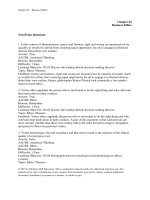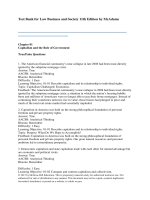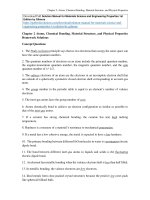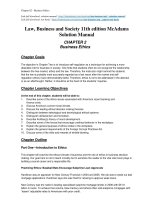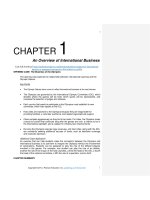testbank for law business and society 11 th edition by mcadams
Bạn đang xem bản rút gọn của tài liệu. Xem và tải ngay bản đầy đủ của tài liệu tại đây (366.39 KB, 22 trang )
Test Bank for Law Business and Society 11th Edition by McAdams
Chapter 01
Capitalism and the Role of Government
True/False Questions
1. The American financial community’s near collapse in late 2008 had been most directly
ignited by the subprime mortgage crisis.
Answer: True
AACSB: Analytical Thinking
Blooms: Remember
Difficulty: 1 Easy
Learning Objective: 01-01 Describe capitalism and its relationship to individual rights.
Topic: Capitalism Challenged: Economics
Feedback: The American financial community’s near collapse in 2008 had been most directly
ignited by the subprime mortgage crisis; a situation in which the nation’s housing bubble
burst and millions of Americans were no longer able to pay their home mortgages. Instead of
continuing their sometimes meteoric rise in value, those homes had plunged in price and
much of the total real estate market had essentially imploded.
2. Capitalism in America was built on the strong philosophical foundation of personal
freedom and private property rights.
Answer: True
AACSB: Analytical Thinking
Blooms: Remember
Difficulty: 1 Easy
Learning Objective: 01-01 Describe capitalism and its relationship to individual rights.
Topic: Purpose: What Do We Hope to Accomplish?
Feedback: Capitalism in America was built on the strong philosophical foundation of
personal freedom and private property rights. Our great natural resources and personal
ambition led to extraordinary prosperity.
3. Democratic capitalism and state capitalism trade with each other for mutual advantage but
are economic and political rivals.
Answer: True
AACSB: Analytical Thinking
Blooms: Remember
Difficulty: 1 Easy
Learning Objective: 01-02 Compare and contrast capitalism and collectivism.
© 2015 by McGraw-Hill Education. This is proprietary material solely for authorized instructor use. Not
authorized for sale or distribution in any manner. This document may not be copied, scanned, duplicated,
forwarded, distributed, or posted on a website, in whole or part.
Topic: Too Much Capitalism? Or Too Little?
Feedback: Democratic capitalism and state capitalism trade with each other for mutual
advantage but are economic and political rivals. Democratic capitalism in the United States,
Japan, Denmark, and other nations favors business to create wealth and government to
regulate as needed. State capitalism in countries such as China, Russia, and Saudi Arabia
employs the market to build wealth, which, in turn, is controlled and distributed by the state
for its political purposes.
4. Capitalism features economic cooperation and varying degrees of centralized control.
Answer: False
AACSB: Analytical Thinking
Blooms: Remember
Difficulty: 1 Easy
Learning Objective: 01-02 Compare and contrast capitalism and collectivism.
Topic: Communism
Feedback: Collectivist systems feature economic cooperation and varying degrees of
centralized control as contrasted with capitalism’s economic individualism and political
freedom.
5. The term collectivism embraces communism and socialism and similar philosophies on the
left side of the political or economic spectrum.
Answer: True
AACSB: Analytical Thinking
Blooms: Remember
Difficulty: 1 Easy
Learning Objective: 01-02 Compare and contrast capitalism and collectivism.
Topic: Communism
Feedback: The term collectivism embraces communism and socialism and similar
philosophies on the left side of the political or economic spectrum. Collectivist systems
feature economic cooperation and varying degrees of centralized control as contrasted with
capitalism’s economic individualism and political freedom.
6. Political scientist Benjamin Barber believes that capitalism drags us into decadence by
encouraging us to buy as many unnecessary products as we can manage.
Answer: True
AACSB: Analytical Thinking
Blooms: Remember
Difficulty: 1 Easy
Learning Objective: 01-02 Compare and contrast capitalism and collectivism.
Topic: Capitalism Challenged: America in Decline?
Feedback: Political scientist Benjamin Barber believes that capitalism drags us into
decadence by encouraging us to buy as many unnecessary products as we can manage, thus
replacing historical principles of hard work and deferred gratification with infantile hungers
for anything that might promise comfort. In America’s version of capitalism, as Barber sees
it, we find liberty in commerce. We can buy whatever we want; therefore, we are free.
7. Socialism embraces totalitarianism while calling for aggressive government intervention to
© 2015 by McGraw-Hill Education. This is proprietary material solely for authorized instructor use. Not
authorized for sale or distribution in any manner. This document may not be copied, scanned, duplicated,
forwarded, distributed, or posted on a website, in whole or part.
correct economic and social ills.
Answer: False
AACSB: Analytical Thinking
Blooms: Remember
Difficulty: 1 Easy
Learning Objective: 01-03 Differentiate between communism and socialism as collectivist
philosophies.
Topic: Socialism
Feedback: Socialists provide one answer by rejecting communist totalitarianism and
embracing democracy while calling for aggressive government intervention to correct
economic and social ills. Historically, socialism has often been associated with democratic
governments and peaceful change, whereas communism has been characterized by
totalitarianism and violent revolution.
8. Capitalists fear the irrationality of a society based on competition and unrestrained pursuit
of industrial growth.
Answer: False
AACSB: Analytical Thinking
Blooms: Remember
Difficulty: 1 Easy
Learning Objective: 01-03 Differentiate between communism and socialism as collectivist
philosophies.
Topic: Socialism
Feedback: Socialists fear the “irrationality” of a society based on competition and
unrestrained pursuit of industrial growth. One of the elements of the socialist agenda is
rationality.
9. Capitalists consider class distinctions unjust.
Answer: False
AACSB: Analytical Thinking
Blooms: Remember
Difficulty: 1 Easy
Learning Objective: 01-03 Differentiate between communism and socialism as collectivist
philosophies.
Topic: Socialism
Feedback: Class distinctions are anathema to the socialist. All humans are equally
meritorious, and distinctions among them are inherently unjust.
10. Communists are convinced that problems of market failure mean that the free market is
simply incapable of meeting the needs of all segments of society.
Answer: False
AACSB: Analytical Thinking
Blooms: Remember
Difficulty: 1 Easy
Learning Objective: 01-03 Differentiate between communism and socialism as collectivist
philosophies.
Topic: Socialism
© 2015 by McGraw-Hill Education. This is proprietary material solely for authorized instructor use. Not
authorized for sale or distribution in any manner. This document may not be copied, scanned, duplicated,
forwarded, distributed, or posted on a website, in whole or part.
Feedback: A critical distinction between socialists and capitalists is that the former believe a
society’s broad directions should be carefully planned rather than left to what some take to be
the whimsy of the market. Furthermore, socialists are convinced that problems of market
failure (inadequate information, monopoly, externalities, public goods, and so on) mean that
the free market is simply incapable of meeting the needs of all segments of society.
11. To pay for its comprehensive welfare benefits, the United States takes 50.1 percent of its
national income in taxes, the highest rate of any industrialized nation.
Answer: False
AACSB: Analytical Thinking
Blooms: Remember
Difficulty: 1 Easy
Learning Objective: 01-04 Evaluate arguments regarding government’s proper role in the
global, technology-based economy.
Topic: American Capitalism in Europe?
Feedback: To pay for its cradle-to-grave welfare benefits, Sweden takes about 45 percent of
its national income (gross domestic product-GDP) in taxes, while the United States, in
contrast, has one of the developed world’s lowest total tax burdens at about 27 percent of
GDP in recent decades, but down to about 24 percent during the recession.
12. Sweden and the other Scandinavian states rely on wise government spending as their key
ingredient in a successful market-based economy.
Answer: True
AACSB: Analytical Thinking
Blooms: Remember
Difficulty: 1 Easy
Learning Objective: 01-05 Describe the primary characteristics of a “mixed economy.”.
Topic: American Capitalism in Europe?
Feedback: For Sweden and the other Scandinavian states, wise government spending is a key
ingredient in a successful market-based economy. We should remember, of course, that
Sweden is a small, homogeneous nation. Replicating its policies in the United States would
be difficult.
13. The pure free market approach adds all forms of government including regulatory
agencies, consumer protection, environmental rules, and antitrust law to our business system
and our society.
Answer: False
AACSB: Analytical Thinking
Blooms: Understand
Difficulty: 2 Medium
Learning Objective: 01-05 Describe the primary characteristics of a “mixed economy.”
Topic: Purpose: What Do We Hope to Accomplish?
Feedback: The pure free market approach assumes that we can operate our business system
and our society at large free of all but foundational legal mechanisms such as contract and
criminal law. Most forms of government including regulatory agencies, consumer protection,
environmental rules, occupational licensure, zoning restrictions, antitrust law, and all but the
most basic government services would be eliminated.
© 2015 by McGraw-Hill Education. This is proprietary material solely for authorized instructor use. Not
authorized for sale or distribution in any manner. This document may not be copied, scanned, duplicated,
forwarded, distributed, or posted on a website, in whole or part.
14. American capitalism, despite its extraordinary success, is criticized for problems of
poverty, inequality, and unfairness.
Answer: True
AACSB: Analytical Thinking
Blooms: Remember
Difficulty: 1 Easy
Learning Objective: 01-06 Analyze the impact of capitalism on equality, fairness, and
community in American and global society
Topic: The American Dream at Risk?
Feedback: American capitalism, despite its extraordinary success, is criticized for problems
of poverty, inequality, and unfairness, among others. The market is driven by and rewards
individual achievement.
15. It is a well-known fact that the United States ranks well on standard social measures and
not so well on standard economic measures.
Answer: False
AACSB: Analytical Thinking
Blooms: Remember
Difficulty: 1 Easy
Learning Objective: 01-06 Analyze the impact of capitalism on equality, fairness, and
community in American and global society.
Topic: The American Dream at Risk?
Feedback: In general, the United States ranks well on standard economic measures and not so
well on standard social measures. America’s 2012 estimated GDP per capita of $50,700
ranked 14th in the world behind smaller, more specialized economies such as Qatar (1st at
$103,900) and Norway (9th at $55,900) but (as it is showing contrast) well ahead of our
chief industrial rivals such as Germany (29th at $39,700) and Japan (38th at $36,900).
16. Taking the privatization movement a step further, state and local governments are selling
or leasing existing roads to private companies.
Answer: True
AACSB: Analytical Thinking
Blooms: Remember
Difficulty: 1 Easy
Learning Objective: 01-07 Discuss the theory and practice of privatization.
Topic: Capitalism in Practice—“Privatization” in America and Abroad
Feedback: Private companies are building, maintaining, and operating new toll roads in
places such as northern Virginia and suburban San Diego to the Mexican border. Taking the
privatization movement a step further, state, and local governments are selling or leasing
existing roads to private companies. Indiana, for example, leased its 157-mile Indiana East–
West Toll Road to an international group for $3.8 billion for 75 years.
17. Privatization often brings substantially reduced costs and improved expertise.
Answer: True
AACSB: Analytical Thinking
Blooms: Remember
© 2015 by McGraw-Hill Education. This is proprietary material solely for authorized instructor use. Not
authorized for sale or distribution in any manner. This document may not be copied, scanned, duplicated,
forwarded, distributed, or posted on a website, in whole or part.
Difficulty: 1 Easy
Learning Objective: 01-07 Discuss the theory and practice of privatization.
Topic: Capitalism in Practice—“Privatization” in America and Abroad
Feedback: Privatization often brings substantially reduced costs and improved expertise, but
sometimes the transition does not work well. Fury might be the best word to describe
consumer reaction to the higher rates and poor service that accompanied Chicago’s parking
meter privatization, but Indiana has used the money from its toll road leases to fund a
popular, 10-year highway improvement program.
18. China’s reliance on cheap labor to drive its economy still remains unchallenged as other
nations are unable to undercut the Chinese advantage.
Answer: False
AACSB: Analytical Thinking
Blooms: Remember
Difficulty: 1 Easy
Learning Objective: 01-08 Discuss the current state of capitalism in China and Russia.
Topic: Coping with Capitalism—China and Russia
Feedback: China’s reliance on cheap labor to drive its economy is threatened as other nations
are able to undercut the Chinese advantage. Despite China’s renewed global prominence and
its stunning economic advances, record numbers of professionals reportedly leave annually.
19. Extravagant wealth, side-by-side with punishing poverty, is perhaps the greatest
disappointment and injustice, from the critics’ point of view, in the global advance of
capitalist principles.
Answer: True
AACSB: Analytical Thinking
Blooms: Remember
Difficulty: 1 Easy
Learning Objective: 01-09 Describe the income and wealth gaps in America.
Topic: The American Dream at Risk?
Feedback: Extravagant wealth, side-by-side with punishing poverty, is perhaps the greatest
disappointment and injustice, from the critics’ point of view, in the global advance of
capitalist principles. The wealthiest 1 percent of Americans now have a greater collective net
worth than the bottom 90 percent.
Multiple Choice Questions
20. In the context of capitalism in America, which of the following most likely led the
government to curb the power of big business?
A. Poor foundation of personal freedom
B. Lack of private property rights
C. Emergence of monopolistic abuse
D. Lack of natural resources
Answer: C
AACSB: Analytical Thinking
Blooms: Understand
© 2015 by McGraw-Hill Education. This is proprietary material solely for authorized instructor use. Not
authorized for sale or distribution in any manner. This document may not be copied, scanned, duplicated,
forwarded, distributed, or posted on a website, in whole or part.
Difficulty: 2 Medium
Learning Objective: 01-01 Describe capitalism and its relationship to individual rights.
Topic: Purpose: What Do We Hope to Accomplish?
Feedback: Capitalism in America was built on the strong philosophical foundation of
personal freedom and private property rights. Our great natural resources and personal
ambition led to extraordinary prosperity. Monopolistic abuse followed, however, and
government grew to curb the power of big business. Thus, America’s substantially free
market was gradually constrained by government regulation.
21. _____ in the United States, Japan, Denmark, and other nations favors business to create
wealth and government to regulate as needed.
A. Democratic capitalism
B. State capitalism
C. Religious socialism
D. Regional socialism
Answer: A
AACSB: Analytical Thinking
Blooms: Remember
Difficulty: 1 Easy
Learning Objective: 01-02 Compare and contrast capitalism and collectivism.
Topic: Too Much Capitalism? Or Too Little?
Feedback: Democratic capitalism in the United States, Japan, Denmark, and other nations
favors business to create wealth and government to regulate as needed. State capitalism in
countries such as China, Russia, and Saudi Arabia employs the market to build wealth,
which, in turn, is controlled and distributed by the state for its political purposes.
22. ____ in countries such as Russia, China, and Saudi Arabia employs the market to build
wealth, which, in turn, is controlled and distributed by the state for its political purposes.
A. Regional socialism
B. Democratic capitalism
C. State capitalism
D. Religious socialism
Answer: C
AACSB: Analytical Thinking
Blooms: Remember
Difficulty: 1 Easy
Learning Objective: 01-08 Discuss the current state of capitalism in China and Russia..
Topic: Too Much Capitalism? Or Too Little?
Feedback: State capitalism in countries such as China, Russia, and Saudi Arabia employs the
market to build wealth, which, in turn, is controlled and distributed by the state for its
political purposes.
23. Which of the following countries follows a communist form of government?
A. The United States
B. Australia
C. China
D. The United Kingdom
© 2015 by McGraw-Hill Education. This is proprietary material solely for authorized instructor use. Not
authorized for sale or distribution in any manner. This document may not be copied, scanned, duplicated,
forwarded, distributed, or posted on a website, in whole or part.
Answer: C
AACSB: Analytical Thinking
Blooms: Remember
Difficulty: 1 Easy
Learning Objective: 01-03 Differentiate between communism and socialism as collectivist
philosophies.
Topic: Communism
Feedback: China follows a communist form of government. Although China, Cuba, North
Korea, Vietnam, and a few other nations continue to practice communism, the balance of the
world has clearly rejected Marxist-Leninist totalitarianism. China is rapidly and
enthusiastically embracing free market practices, with continuing state direction; a strategy
that some label state capitalism.
24. _____ was particularly concerned about the growing imbalance between rich and poor
and felt that the pursuit of wealth and self-interest would erode society’s moral core.
A. Ayn Rand
B. Bo Xilai
C. Karl Marx
D. Anatole Kaletsky
Answer: C
AACSB: Analytical Thinking
Blooms: Remember
Difficulty: 1 Easy
Learning Objective: 01-03 Differentiate between communism and socialism as collectivist
philosophies.
Topic: Communism
Feedback: Karl Marx’s central message concerns the severe abuses that can accompany
unrestrained capitalism. Marx was particularly concerned about the growing imbalance
between rich and poor. Moreover, he felt that the pursuit of wealth and self-interest would
erode society’s moral core.
25. Socialism has been associated with _____.
A. self-interest and strong pursuit of individual wealth
B. democratic governments and peaceful change
C. totalitarianism and violent revolution
D. economic individualism
Answer: B
AACSB: Analytical Thinking
Blooms: Remember
Difficulty: 1 Easy
Learning Objective: 01-03 Differentiate between communism and socialism as collectivist
philosophies.
Topic: Socialism
Feedback: Socialists provide one answer by rejecting communist totalitarianism and
embracing democracy while calling for aggressive government intervention to correct
economic and social ills. Historically, socialism has often been associated with democratic
governments and peaceful change, whereas communism has been characterized by
© 2015 by McGraw-Hill Education. This is proprietary material solely for authorized instructor use. Not
authorized for sale or distribution in any manner. This document may not be copied, scanned, duplicated,
forwarded, distributed, or posted on a website, in whole or part.
totalitarianism and violent revolution.
26. Identify the correct statement regarding socialists.
A. They aim to retain the benefits of industrialism while abolishing the social costs often
accompanying the free market.
B. They reserve much of their concern for the condition of the middle and higher classes.
C. They reject the need for aggressive government intervention to correct economic and
social ills.
D. They embrace communist totalitarianism and reject democracy.
Answer: A
AACSB: Analytical Thinking
Blooms: Understand
Difficulty: 2 Medium
Learning Objective: 01-03 Differentiate between communism and socialism as collectivist
philosophies.
Topic: Socialism
Feedback: Socialists aim to retain the benefits of industrialism while abolishing the social
costs often accompanying the free market. The government is likely to be directly involved in
regulating growth, inflation, and unemployment.
27. Which of the following statements about socialists is true?
A. Socialists feel that the economy must be directed toward the welfare of the successful
capitalists.
B. Socialists reserve much of their concern for the condition of the higher class.
C. The harshness of working life is not objected by socialists.
D. Class distinctions are anathema to socialists.
Answer: D
AACSB: Analytical Thinking
Blooms: Remember
Difficulty: 1 Easy
Learning Objective: 01-03 Differentiate between communism and socialism as collectivist
philosophies.
Topic: Socialism
Feedback: Class distinctions are anathema to socialists. All humans are equally meritorious,
and distinctions among them are inherently unjust.
28. Which of the following statements corresponds to Karl Marx’s beliefs?
A. The mode of production in material life determines the general character of the social,
political, and spiritual processes of life.
B. Unrestrained capitalism would do the society good.
C. The pursuit of wealth and self-interest by individuals will continuously build the society’s
moral core.
D. Competition and unrestrained pursuit of industrial growth is essential for the welfare of
the capitalists.
Answer: A
AACSB: Analytical Thinking
Blooms: Understand
© 2015 by McGraw-Hill Education. This is proprietary material solely for authorized instructor use. Not
authorized for sale or distribution in any manner. This document may not be copied, scanned, duplicated,
forwarded, distributed, or posted on a website, in whole or part.
Difficulty: 2 Medium
Learning Objective: 01-03 Differentiate between communism and socialism as collectivist
philosophies.
Topic: Communism
Feedback: Karl Marx was particularly concerned about the growing imbalance between rich
and poor. Moreover, he felt that the pursuit of wealth and self-interest would erode society’s
moral core. Marx built an economic interpretation of history, arguing that “the mode of
production in material life determines the general character of the social, political, and
spiritual processes of life.”
29. Which of the following is true of Robert Putnam’s observations on social capital?
A. Putnam observed that the practice of free market principles is essential for a moral life.
B. Putnam observed that a sharp rise was seen in league bowling from 1980 to 2000, although
the number of bowlers decreased by about 10 percent.
C. Putnam observed that virtually every measure of social interaction fell significantly from
roughly 1975 to 2000.
D. Putnam observed that only three categories of government were necessary: the police, the
armed services, and the law courts.
Answer: C
AACSB: Analytical Thinking
Blooms: Understand
Difficulty: 2 Medium
Learning Objective: 01-09 Discuss the income and wealth gaps in America.Topic: The
American Dream at Risk?
Feedback: Robert Putnam’s book explains that virtually every measure of social interaction,
from voting to picnics to playing cards, to church attendance, to membership in social clubs
fell significantly from roughly 1975 to 2000. The most vivid example was a decline of 40
percent in league bowling from 1980 to 2000 although the total number of bowlers increased
by about 10 percent; thus the notion of “bowling alone.”
30. Identify the underlying reason why socialists advocate income supports, free education,
free health care, generous sick pay, and family planning.
A. Socialists believe that the economy must be directed toward the general interest rather
than left free to multiply the welfare of successful capitalists.
B. Socialists seek an excessively individualistic approach to life where the communitarian
approach of capitalism is muted by a concern for the welfare of all.
C. Socialists believe that communism harshly restrains individual freedom and creates a
society based on unrestrained pursuit of industrial growth.
D. Socialists seek to embrace totalitarianism while calling for aggressive government
intervention.
Answer: A
AACSB: Analytical Thinking
Blooms: Understand
Difficulty: 2 Medium
Learning Objective: 01-03 Differentiate between communism and socialism as collectivist
philosophies.
Topic: Socialism
© 2015 by McGraw-Hill Education. This is proprietary material solely for authorized instructor use. Not
authorized for sale or distribution in any manner. This document may not be copied, scanned, duplicated,
forwarded, distributed, or posted on a website, in whole or part.
Feedback: Socialists believe that the economy must be directed toward the general interest
rather than left free to multiply the welfare of successful capitalists. Hence, socialists
advocate income supports, free education, free health care, generous sick pay, family
planning, and the like to correct the failures of capitalism.
31. Which of the following views was advocated by Ayn Rand, the philosopher and novelist?
A. The necessary categories of government were only three in number: the police, the armed
services, and the law courts.
B. The practice of free market principles is not needed for a rational, moral life.
C. The mode of production in material life determines the general character of the social,
political, and spiritual processes of life.
D. The theory of market fundamentalism is a greater threat to open society today than
communism.
Answer: A
AACSB: Analytical Thinking
Blooms: Remember
Difficulty: 1 Easy
Learning Objective: 01-04 Evaluate arguments regarding government’s proper role in the
global, technology-based economy.
Topic: Purpose: What Do We Hope to Accomplish?
Feedback: The controversial philosopher and novelist Ayn Rand was an uncompromising
advocate of free market principles. She believed the necessary categories of government were
only three in number: the police, the armed services, and the law courts.
32. The proper balance between _____ remains the central public policy debate in American
life.
A. open markets and government intervention
B. personal freedom and private property rights
C. natural resources and personal ambition
D. intellectual freedom and social order
Answer: A
AACSB: Analytical Thinking
Blooms: Remember
Difficulty: 1 Easy
Learning Objective: 01-04 Evaluate arguments regarding government’s proper role in the
global, technology-based economy.
Topic: Purpose: What Do We Hope to Accomplish?
Feedback: America’s substantially free market was constrained by government regulation.
The proper balance between open markets and government intervention remains perhaps the
central public policy debate in American life.
33. What efforts have been made by Sweden to keep its economy healthy?
A. It has taken an aggressive cowboy capitalism approach.
B. It has followed a policy of comparatively low corporate taxes.
C. It has permitted the sale or lease of public assets to private parties.
D. It has attracted billions in private sector investment to take over a few dozen statecontrolled companies.
© 2015 by McGraw-Hill Education. This is proprietary material solely for authorized instructor use. Not
authorized for sale or distribution in any manner. This document may not be copied, scanned, duplicated,
forwarded, distributed, or posted on a website, in whole or part.
Answer: B
AACSB: Analytical Thinking
Blooms: Remember
Difficulty: 1 Easy
Learning Objective: 01-04 Evaluate arguments regarding government’s proper role in the
global, technology-based economy.
Topic: American Capitalism in Europe?
Feedback: In order to keep its economy healthy, Sweden has followed a policy of
comparatively low total corporate taxes (22 percent as compared with a U.S. rate of 39.2
percent, federal and state combined, although with loopholes included, the U.S. effective rate
is an estimated 29.2 percent).
34. Which of the following is most likely to be a result of a country maintaining its core
welfare commitment in combination with an entrepreneurial spirit?
A. An economy of relatively low unemployment, low inflation, and high GDP growth
B. An economy that is impoverished and filled with inequality
C. An economy encompassing poverty, oppression, and the rich-poor gap
D. An economy that has only state-dominated companies with high employment due to the
encouragement of welfare over work
Answer: A
AACSB: Analytical Thinking
Blooms: Understand
Difficulty: 2 Medium
Learning Objective: 01-05 Describe the primary characteristics of a “mixed economy.” (or
both?).
Topic: American Capitalism in Europe?
Feedback: The pressure of globalization has been felt in Sweden where a more moderate and
somewhat right-center government has pushed aside the left-leaning Social Democrats and
has significantly lowered taxes, privatized some state-dominated companies, and reduced
unemployment by encouraging work over welfare. The result is an economy of relatively low
unemployment, low inflation, and high GDP growth.
35. In terms of markets and governments, the United States:
A. has more faith in government planning.
B. has placed less faith in the market.
C. chose a capitalist, democratic approach to life.
D. reflects a preference for greater central authority.
Answer: C
AACSB: Analytical Thinking
Blooms: Remember
Difficulty: 1 Easy
Learning Objective: 01-05 Describe the primary characteristics of a “mixed economy.”
Topic: Purpose: What Do We Hope to Accomplish?
Feedback: America’s system of laws can be understood with a firm appreciation for the
principles of capitalism from which those laws spring. The United States has embraced an
evolving capitalist, democratic approach to life.
© 2015 by McGraw-Hill Education. This is proprietary material solely for authorized instructor use. Not
authorized for sale or distribution in any manner. This document may not be copied, scanned, duplicated,
forwarded, distributed, or posted on a website, in whole or part.
36. In the context of economic systems, the “Third Way” refers to _____.
A. totalitarianism
B. market socialism
C. capitalism
D. communism
Answer: B
AACSB: Analytical Thinking
Blooms: Remember
Difficulty: 1 Easy
Learning Objective: 01-05 Describe the primary characteristics of a “mixed economy.”
Topic: American Capitalism in Europe?
Feedback: For years, the Nordic states of Sweden, Norway, Denmark, and Finland practiced
their market socialism or social democracy with such success that it was labeled a “Third
Way” between the harsher extremes of capitalism and communism. Their welfare states
provided healthy economic growth with cradle-to-grave social care for all in a system
emphasizing the collective welfare over individual preferences.
37. Which of the following countries followed the “Third Way” between the harsher
extremes of capitalism and communism?
A. Sweden
B. U.S.A
C. China
D. Russia
Answer: A
AACSB: Analytical Thinking
Blooms: Remember
Difficulty: 1 Easy
Learning Objective: 01-05 Describe the primary characteristics of a “mixed economy.”
Topic: American Capitalism in Europe?
Feedback: For years, the Nordic states of Sweden, Norway, Denmark, and Finland practiced
their market socialism or social democracy with such success that it was labeled a “Third
Way” between the harsher extremes of capitalism and communism. Their welfare states
provided healthy economic growth with cradle-to-grave social care for all in a system
emphasizing the collective welfare over individual preferences.
38. The pure free market approach assumes that:
A. less faith should be placed in the market and more in government planning.
B. legal systems in all countries should reflect a preference for greater central authority.
C. centralized authority will result in a free government and economy free of corruption.
D. business structures and societies can be operated at large free of all but foundational legal
mechanisms.
Answer: D
AACSB: Analytical Thinking
Blooms: Remember
Difficulty: 1 Easy
Learning Objective: 01-01 Describe capitalism and its relationship to individual rights.
Topic: Purpose: What Do We Hope to Accomplish?
© 2015 by McGraw-Hill Education. This is proprietary material solely for authorized instructor use. Not
authorized for sale or distribution in any manner. This document may not be copied, scanned, duplicated,
forwarded, distributed, or posted on a website, in whole or part.
Feedback: The pure free market approach assumes that we can operate our business system
and our society at large free of all but foundational legal mechanisms such as contract and
criminal law. The wisdom of the market—our individual judgments, in combination with our
individual consciences—would “regulate” American life.
39. Which of the following is true of the criticisms of Robert Putnam’s thesis?
A. Robert Putnam was criticized for focusing too much on older activities such as social
clubs.
B. Robert Putnam was criticized for focusing too much on emerging interests such as Internet
groups.
C. Robert Putnam was criticized for his belief that the necessary categories of government
were only three in number: the police, the armed services, and the law courts.
D. Robert Putnam was criticized for his belief that state capitalism as practiced in Russia can
succeed in the face of political repression, routine corruption, and abuse of the rule of law.
Answer: A
AACSB: Analytical Thinking
Blooms: Understand
Difficulty: 2 Medium
Learning Objective: 01-06 Analyze the impact of capitalism on equality, fairness, and
community in American and global society.
Topic: The American Dream at Risk?
Feedback: Criticism of Robert Putnam’s thesis was abundant with many saying he focused
too much on “older” activities such as social clubs and not enough on emerging interests such
as Internet groups. Putnam’s more recent research has produced no convincing evidence of
rising community engagement among adults, but he acknowledges they are reaching one
another in different ways from the past, principally through social media.
40. Identify the result of a growing gap in opportunities among socioeconomic classes of
American children.
A. Children of the well-off express increasing trust in those around them.
B. Participation in extracurricular activities has fallen sharply for affluent children.
C. Young products of affluent America have withdrawn or never undertaken community
engagement.
D. Overall community engagement gap between whites and blacks is narrow.
Answer: A
AACSB: Analytical Thinking
Blooms: Understand
Difficulty: 2 Medium
Learning Objective: 01-09 Describe the income and wealth gaps in America.
Topic: The American Dream at Risk?
Feedback: A generation ago, Robert Putnam says, participation in extracurricular activities
varied little by social class, but today participation has risen sharply for affluent children
while falling sharply among those less well-off. One of the results of this opportunity divide
is that children of the well-off express increasing trust in those around them while that trust
has “collapsed” among the less well-off children.
41. Which of the following involves making a service more expensive at times of peak
© 2015 by McGraw-Hill Education. This is proprietary material solely for authorized instructor use. Not
authorized for sale or distribution in any manner. This document may not be copied, scanned, duplicated,
forwarded, distributed, or posted on a website, in whole or part.
demand in order to curb that demand?
A. Median pricing
B. Clearance pricing
C. Predatory pricing
D. Congestion pricing
Answer: D
AACSB: Analytical Thinking
Blooms: Remember
Difficulty: 1 Easy
Learning Objective: 01-07 Discuss the theory and practice of privatization.
Topic: Capitalism in Practice—“Privatization” in America and Abroad
Feedback: While adding to and upgrading infrastructure through privatization, governments
and their agents are also turning to pricing or market mechanisms to reduce demand for that
infrastructure. One expanding initiative is congestion pricing that involves making a service
more expensive at times of peak demand in order to curb that demand.
42. Identify a reason why some parents and school boards have adopted a free market “fix.”
A. Parents and school boards are convinced that replacing merit-based admission with an
auction allowing space to the highest bidders is the only way to raise the academic profile of
an educational institution.
B. Parents and school boards hope that competition will push all schools to higher
achievement levels.
C. Studies reveal that achievement growth rates were twice as high in districts with a free
market fix than in standard public schools.
D. Studies carried out in other countries reveal that market-based approaches such as open
enrollment and charter schools work better than direct payment to students of $100 to $500
per year for improved performance.
Answer: B
AACSB: Analytical Thinking
Blooms: Understand
Difficulty: 2 Medium
Learning Objective: 01-07 Discuss the theory and practice of privatization.
Topic: Capitalism in Practice—“Privatization” in America and Abroad
Feedback: The idea that capitalism was the answer to poor school performance was
unthinkable a few decades ago, but some increasingly frustrated parents and school boards
have adopted a free market “fix.” Schools are experimenting with market-based approaches
such as for-profit web-based classes, open enrollment, charter schools, and vouchers. The
hope is that competition will push all schools to higher achievement levels.
43. In the context of toll roads, parking meters, and congestion pricing, which of the
following is true of privatization?
A. Privatization brings secure working conditions, increased services, and increased
responsiveness to customers.
B. Some struggling governments see privatization as a solution for financial distress.
C. Growing government revenue problems suggest that privatization of transportation will
cease to exist.
D. Privatization often brings increased costs and higher customer dissatisfaction.
© 2015 by McGraw-Hill Education. This is proprietary material solely for authorized instructor use. Not
authorized for sale or distribution in any manner. This document may not be copied, scanned, duplicated,
forwarded, distributed, or posted on a website, in whole or part.
Answer: B
AACSB: Analytical Thinking
Blooms: Understand
Difficulty: 2 Medium
Learning Objective: 01-07 Discuss the theory and practice of privatization.
Topic: Capitalism in Practice—“Privatization” in America and Abroad
Feedback: Critics worry about declining service, excessive tolls, too much profit for the
investors, pricing poorer drivers out of access to the roads, and trading secure government
jobs with benefits for low-wage private-sector jobs without benefits. Nonetheless, increasing
government revenue problems suggest that transportation privatization will continue.
44. How do privatization supporters envision major changes to daily life?
A. By promising economic justice for all
B. By promoting religiosity and building peace
C. By citing free market efficiency and personal freedom while challenging moral
conventions
D. By encouraging economic cooperation and varying degrees of centralized control
Answer: C
AACSB: Analytical Thinking
Blooms: Understand
Difficulty: 2 Medium
Learning Objective: 01-07 Discuss the theory and practice of privatization.
Topic: Capitalism in Practice—“Privatization” in America and Abroad
Feedback: Citing free market efficiency and personal freedom while challenging moral
conventions, privatization supporters envision major changes to daily life. For example, some
doctors and others are arguing for lifting the federal ban on organ sales as a way of
addressing the current donor shortage.
45. Which of the following statements about the economic and political issues of China is
true?
A. The per capita gross domestic product of China is the highest in the world.
B. China’s free market liberalization policies of recent years have paced faster, making entry
to the Chinese market and competition with Chinese companies very easy.
C. China’s gap between rich and poor is estimated to be the world’s largest.
D. Interest in Buddhism has re-emerged after being suppressed during the anti-intellectual
Cultural Revolution of 1966-76.
Answer: C
AACSB: Analytical Thinking
Blooms: Remember
Difficulty: 1 Easy
Learning Objective: 01-08 Discuss the current state of capitalism in China and Russia.
Topic: Coping with Capitalism—China and Russia
Feedback: China’s income gap between rich and poor is estimated to be among the world’s
largest, although China has reduced the disparity in recent years. Furthermore, China has
instituted new environmental rules, corruption crackdowns, and social service initiatives.
46. In the context of state capitalism, explain why government is the dominant economic
© 2015 by McGraw-Hill Education. This is proprietary material solely for authorized instructor use. Not
authorized for sale or distribution in any manner. This document may not be copied, scanned, duplicated,
forwarded, distributed, or posted on a website, in whole or part.
force.
A. The government intervenes in and shapes the market to further the state’s political goals.
B. The intensity of income disparity between the rich and the poor is relatively low.
C. State capitalism favors business to create wealth and government to regulate as needed.
D. State capitalism fails to blend a shrinking system of state-owned enterprise with the power
of the free market.
Answer: A
AACSB: Analytical Thinking
Blooms: Understand
Difficulty: 2 Medium
Learning Objective: 01-08 Discuss the current state of capitalism in China and Russia.
Topic: Coping with Capitalism—China and Russia
Feedback: China and some other nations practice what is sometimes labeled “state
capitalism” in which the government is the dominant economic force as it intervenes in and
shapes the market to further the state’s political goals. The result has been something of an
economic miracle as China has blended its large but shrinking system of state-owned
enterprise with the explosive power of the free market (guided by the government) to sprint
ahead of Japan and become in 2010 the globe’s second ranking economy as measured by
gross national product.
47. According to Robert Putnam, which of the following is true of the growing gap in
opportunities among socioeconomic classes of American children?
A. Young products of affluent America have withdrawn or never undertaken community
engagement.
B. Today, participation in extracurricular activities has risen sharply for less well-off while
falling sharply for affluent children.
C. Today, the more comfortable class of children receive about one hour per day more time
with their parents than less advantaged children.
D. Less affluent young whites have steadily deepened their community engagements.
Answer: C
AACSB: Analytical Thinking
Blooms: Understand
Difficulty: 2 Medium
Learning Objective: 01-09 Describe the income and wealth gaps in America.
Topic: The American Dream at Risk?
Feedback: Robert Putnam has for the last few years been collecting data about the growing
gap in opportunities among socioeconomic classes of American children. In decades past,
parents with high school educations invested money and time in their children at much the
same level as college-graduate parents, but today a large gap has grown in both resources,
favoring, of course, the more affluent families. Specifically, the more comfortable class of
children receive about one hour per day more time with their parents than do less advantaged
children.
Essay Questions
© 2015 by McGraw-Hill Education. This is proprietary material solely for authorized instructor use. Not
authorized for sale or distribution in any manner. This document may not be copied, scanned, duplicated,
forwarded, distributed, or posted on a website, in whole or part.
48. Elaborate on the events that led to a grassroots global protest movement labeled Occupy
Wall Street.
Answer: Many Americans are puzzled, if not angered, by the government’s inability to
criminally punish the big banks and bankers who profited so handsomely in the events that
led to the nation’s economic collapse and who, in several cases, had to be bailed out with
public money following the collapse. Those same bankers have not only escaped jail, but they
continue to earn stunning sums of money. Responding, however, to harsh publicity, among
other factors, some of the big banks have either cut or curbed executive pay.
CEO salaries for the top 200 U.S. corporations (not limited to bankers) rose 16 percent in
2012.
Among those top 200 CEOs, the average income was 273 times the income of the average
worker—up from a 20 to 1 ratio in 1965. Congress showed its concern about CEO pay in a
Dodd-Frank provision requiring the Securities and Exchange Commission to give
shareholders a “say on pay” by writing new rules requiring periodic shareholder voting on
executive compensation. At this writing, “say on pay” seems to have encouraged attention to
CEO pay, but a shareholder backlash has not yet materialized.
Anger with corporate greed and perceived abuse of power led to a grassroots global protest
movement labeled Occupy Wall Street. Hundreds of peaceful protesters (mostly young, often
college-educated and jobless) camped in New York’s financial district in late 2011 to “restore
democracy” while denouncing the “greed” and “corruption” of the “upper 1 percent.” The
movement then spread to many other American cities and around the globe. Occupy Wall
Street gained enormous publicity as a leftist assault on corporate America and the wealthy,
but the movement sputtered—perhaps for want of a clear, coherent message. Occupy Wall
Street continues its efforts, but at least for the present, the attention of the broader American
public has been lost.
AACSB: Analytical Thinking
Blooms: Understand
Difficulty: 2 Medium
Learning Objective: 01-04 Evaluate arguments regarding government’s proper role in the
global, technology-based economy.
Topic: Capitalism Challenged: Morality
49. Describe the chief characteristics of socialists.
Answer: The socialist agenda includes these elements:
a. Liberty. To the capitalist, socialism appears to harshly restrain individual freedom. To the
socialist, the freedoms of capitalism are largely an illusion, accessible only to the prosperous
and powerful.
b. Social welfare. Socialists reserve much of their concern for the condition of the lower
class—poverty, exploitation, cultural deprivation, and so on. Socialists believe that the
economy must be directed toward the general interest rather than left free to multiply the
welfare of successful capitalists. Hence, socialists advocate income supports, free education,
free health care, generous sick pay, family planning, and the like to correct the failures of
capitalism.
c. Fulfilling work. Socialists object to the harshness of working life where a large segment of
society is chained to degrading labor.
d. Community. Socialists seek a communitarian approach to life where the excessive
individualism of capitalism is muted by a concern for the welfare of all.
© 2015 by McGraw-Hill Education. This is proprietary material solely for authorized instructor use. Not
authorized for sale or distribution in any manner. This document may not be copied, scanned, duplicated,
forwarded, distributed, or posted on a website, in whole or part.
e. Equality. Class distinctions are anathema to the socialist. All humans are equally
meritorious, and distinctions among them are inherently unjust.
f. Rationality. Socialists fear the “irrationality” of a society based on competition and
unrestrained pursuit of industrial growth.
AACSB: Analytical Thinking
Blooms: Remember
Difficulty: 1 Easy
Learning Objective: 01-03 Differentiate between communism and socialism as collectivist
philosophies.
Topic: Socialism
50. Describe the effects of globalization.
Answer: Globalization represents the international flowering of capitalism in the sense that
the power of free markets is being embraced, enthusiastically or reluctantly, almost
everywhere on Earth. That power raised new threats, of course, including the spread of
America’s corporate influence and values around the globe. Now, however, globalization
seems to be entering a new phase. In a “hyper-connected,” “flat” world, we are all linked
together in an economic and cultural intimacy scarcely imaginable a few decades back, but
new evidence suggests that a period of “de-globalization” may be emerging. International
trade and money flows are slowing or actually declining. Globalization has succeeded in
raising wages significantly in emerging powers such as China and India. As a result,
manufacturing jobs are returning to America in surprising numbers. Of course, globalization
is not vanishing, but its economic advantages are shifting and new nationalistic urges threaten
to slow the pace of global linkages.
AACSB: Analytical Thinking
Blooms: Understand
Difficulty: 2 Medium
Learning Objective: 01-04 Evaluate arguments regarding government’s proper role in the
global, technology-based economy.
Topic: Capitalism Challenged: Economics
51. Explain how Sweden’s economic health improved due to its adoption of a policy of
comparatively low total corporate tax.
Answer: To pay for its cradle-to-grave welfare benefits, Sweden takes about 45 percent of its
national income (gross domestic product-GDP) in taxes, while the United States, in contrast,
has one of the developed world’s lowest total tax burdens at about 27 percent of GDP in
recent decades, but down to about 24 percent during the recession. In order to keep its
economy healthy, Sweden has followed a policy of comparatively low total corporate taxes.
As a result, Sweden’s economic performance over the past 20 years has been among the
strongest in the world, supporting, for example, a health care system that exceeds U.S. health
care on almost all performance measures but costs less than half as much per person
(although waiting times for some nonemergency services might be considerably longer in
Sweden).
Even so, the pressure of globalization has been felt in Sweden where a more moderate and
somewhat right-center government has pushed aside the left-leaning Social Democrats and
has significantly lowered taxes, privatized some state-dominated companies, and reduced
unemployment by encouraging work over welfare. Business regulations have been
© 2015 by McGraw-Hill Education. This is proprietary material solely for authorized instructor use. Not
authorized for sale or distribution in any manner. This document may not be copied, scanned, duplicated,
forwarded, distributed, or posted on a website, in whole or part.
dramatically reduced, and tens of thousands of long-term unemployed welfare recipients have
been pushed back into the labor market. Sweden hopes to maintain its core welfare
commitment in combination with an entrepreneurial spirit more like America’s. The result is
an economy of relatively low unemployment, low inflation, and high GDP growth.
AACSB: Analytical Thinking
Blooms: Understand
Difficulty: 2 Medium
Learning Objective: 01-04 Evaluate arguments regarding government’s proper role in the
global, technology-based economy.
Topic: American Capitalism in Europe?
52. Define privatization, providing examples.
Answer: Championed in the 1980s by President Ronald Reagan in the United States and
Prime Minister Margaret Thatcher in Great Britain, nations across the globe along with many
American states and cities have turned to privatization both to address financial problems and
to satisfy ideological preferences for smaller governments. Most commonly, privatization
follows two patterns: (1) contracting out where government, in effect, turns over a portion of
its duties, such as garbage collection, to a private firm; and (2) the sale or lease of public
assets, such as an airport, to a private party. Privately operated prisons, now rather common
across America, are a primary example of the privatization movement.
AACSB: Analytical Thinking
Blooms: Understand
Difficulty: 2 Medium
Learning Objective: 01-07 Discuss the theory and practice of privatization.
Topic: Capitalism in Practice—“Privatization” in America and Abroad
53. Describe the major criticisms or concerns about the privatization of toll roads.
Answer: Private companies are building, maintaining, and operating new toll roads in places
such as northern Virginia, suburban San Diego to the Mexican border. Taking the
privatization movement a step further, state and local governments are selling or leasing
existing roads to private companies. Indiana, for example, leased its 157-mile Indiana East–
West Toll Road to an international group for $3.8 billion for 75 years. The new operators can
raise tolls each year by 2 percent, the inflation rate, or the increase in GDP; whichever is
higher. Critics worry, however, about declining service, excessive tolls, too much profit for
the investors, pricing poorer drivers out of access to the roads, and trading secure government
jobs with benefits for low-wage private sector jobs without benefits. Nonetheless, increasing
government revenue problems suggest that transportation privatization will continue.
AACSB: Analytical Thinking
Blooms: Understand
Difficulty: 2 Medium
Learning Objective: 01-07 Discuss the theory and practice of privatization.
Topic: Capitalism in Practice—“Privatization” in America and Abroad
54. Elaborate on the changing labor market trend and the problems faced by China.
Answer: China and some other nations practice what is sometimes labeled “state capitalism”
in which the government is the dominant economic force as it intervenes in and shapes the
market to further the state’s political goals. The result has been something of an economic
© 2015 by McGraw-Hill Education. This is proprietary material solely for authorized instructor use. Not
authorized for sale or distribution in any manner. This document may not be copied, scanned, duplicated,
forwarded, distributed, or posted on a website, in whole or part.
miracle as China has blended its large but shrinking system of state-owned enterprise with the
explosive power of the free market (guided by the government) to sprint ahead of Japan and
become in 2010 the globe’s second ranking economy as measured by gross national product.
China faces many problems, particularly as it attempts to balance its export-led economy with
increased domestic consumer spending. Stunning levels of environmental pollution; stock
market manipulation; dangerous foods and drugs; rampant piracy of software, movies, and
music; and government corruption are among those difficulties. Basic social support
structures like affordable access to health care, unemployment insurance, and pensions
remain inadequate. More broadly, China’s income gap between rich and poor is estimated to
be among the world’s largest, although China has reduced the disparity in recent years.
Furthermore, China has instituted new environmental rules, corruption crackdowns, and
social service initiatives.
Low wages, often difficult working conditions, and a rapidly shrinking supply of young
laborers (the result of strict family planning policies) have caused unrest among workers
leading to occasional strikes and some increase in wages, although those wages remain low
relative to the economy’s overall health. China’s reliance on cheap labor to drive its economy
is threatened as other nations are able to undercut the Chinese advantage. Despite China’s
renewed global prominence and its stunning economic advances, record numbers of
professionals reportedly leave annually.
AACSB: Analytical Thinking
Blooms: Understand
Difficulty: 2 Medium
Learning Objective: 01-08 Discuss the current state of capitalism in China and Russia.
Topic: Coping with Capitalism—China and Russia
55. Explain Robert Putnam’s view on the impact of declining community and growing gap in
opportunities among socioeconomic classes of American children.
Answer: Robert Putnam has for the last few years been collecting data about the growing gap
in opportunities among socioeconomic classes of American children. In decades past, parents
with high school educations invested money and time in their children at much the same level
as college-graduate parents, but today a large gap has grown in both resources, favoring, of
course, the more affluent families. Specifically, the more comfortable class of children
receive about one hour per day more time with their parents than do less advantaged children.
A generation ago, Putnam says, participation in extracurricular activities varied little by
social class, but today participation has risen sharply for affluent children while falling
sharply among those less well-off. One of the results of this opportunity divide is that
children of the well-off express increasing trust in those around them while that trust has
“collapsed” among the less well-off children.
Likewise, young products of affluent America have steadily deepened their community
engagement (going to church more, better connecting to their parents, volunteering) while the
less affluent young whites have withdrawn or never undertaken that engagement. That
disparity in involvement is not present among young blacks, but the overall engagement gap
between whites and blacks is wide.
AACSB: Analytical Thinking
Blooms: Understand
Difficulty: 2 Medium
Learning Objective: 01-09 Describe the income and wealth gaps in America.
© 2015 by McGraw-Hill Education. This is proprietary material solely for authorized instructor use. Not
authorized for sale or distribution in any manner. This document may not be copied, scanned, duplicated,
forwarded, distributed, or posted on a website, in whole or part.
Topic: The American Dream at Risk?
© 2015 by McGraw-Hill Education. This is proprietary material solely for authorized instructor use. Not
authorized for sale or distribution in any manner. This document may not be copied, scanned, duplicated,
forwarded, distributed, or posted on a website, in whole or part.

